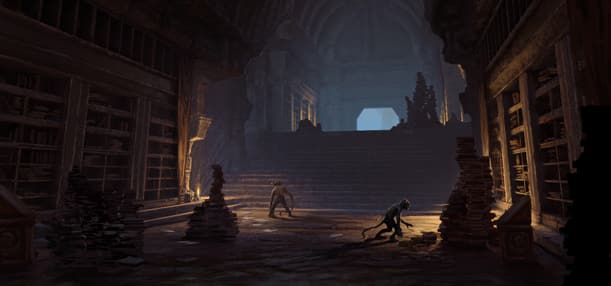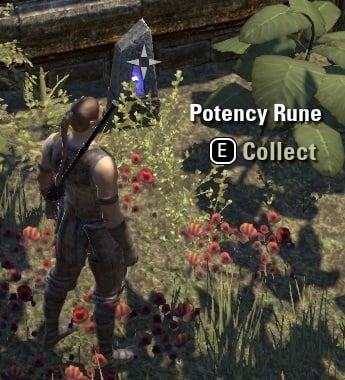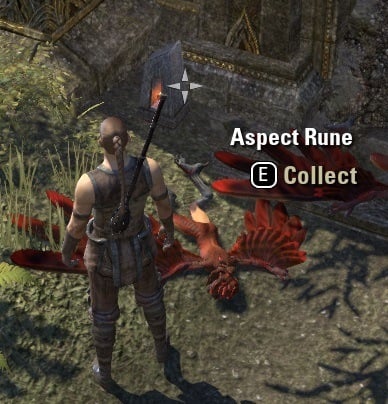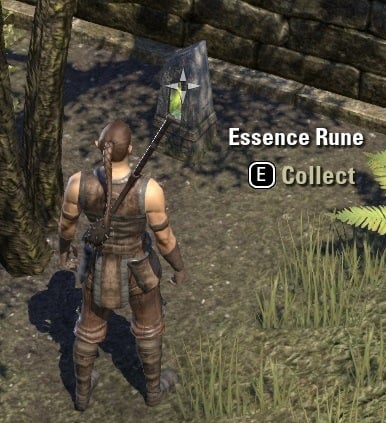TESOの付呪はタムリエルにあるルーンストーンを集め、グリフを作るクラフト。そのグリフには鎧、武器、アクセサリに魔法をかけ、付呪でより強くします。
ルーンストーン
ルーンストーン ページにリストがあります。
付呪師は世界各地にあるルーンを彙め、 付呪台を使ってルーンを組み合わせてクリフにすると、 消耗されていたり使用済みのアイテムの鮪力を向上させることかできます。 へルプのクリフの嬌で使い方を見ることかできます。
付呪台で抽出のタブを閲〈と、 クリフか5ル一ンを抜き出すこともできます。 抽出を行うには所持品かぅ夕リフを遣ぴます。 抽出を行うと夕リフは燻れてしまうことを賞えておいてください。
- 効カ (□)はグリフのレベルを決める。『プラス効カルーンストーン』と『マイナス効カルーンストーン』に分かれます。
- 晶貿 (○) はグリフのクオリティを決める。
- 本費 (△)は魔法効稟を決める。
グリフ
Enchanters create Glyphs by combining runes of three different types: Potency, Aspect and Essence. They can then create Armor, Weapon and Jewelery glyphs depending on unlocked skills and available materials.
Please see the グリフ page for a detailed list of all available glyphs.
Runes can also be extracted from Glyphs by opening the "Extraction" tab at an enchanting table. Chose a Glyph from your Inventory to perform an extraction. Remember that performing the extraction process will destroy the Glyph.
付呪ヒント
| Name & Image |
Rank | Description |
Unlock Tree Level |
|---|---|---|---|
 Aspect Improvement(Passive Skill) |
Rank I |
|
Enchanting Rank 01 |
| Rank II |
|
Enchanting Rank 06 | |
| Rank III |
|
Enchanting Rank 16 | |
| Rank IV |
|
Enchanting Rank 31 | |
 Potency Improvement(Passive Skill) |
Rank I | Enchanting Rank 01 | |
| Rank II | Enchanting Rank 05 | ||
| Rank III | Enchanting Rank 10 | ||
| Rank IV | Enchanting Rank 15 | ||
| Rank V | Enchanting Rank 20 | ||
| Rank VI |
|
Enchanting Rank 25 | |
| Rank VII |
|
Enchanting Rank 30 | |
| Rank VIII |
|
Enchanting Rank 35 | |
| Rank IX |
|
Enchanting Rank ?? | |
| Rank X | Enchanting Rank ?? | ||
 Keen Eye Runestones(Passive Skill) |
Rank I |
|
Enchanting Rank 02 |
| Rank II |
|
Enchanting Rank 07 | |
| Rank III |
|
Enchanting Rank ?? | |
 Hireling(Passive Skill) |
Rank I |
|
Enchanting Rank 03 |
| Rank II |
|
Enchanting Rank 12 | |
| Rank III |
|
Enchanting Rank 32 | |
 Aspect Extraction(Passive Skill) |
Rank I |
|
Enchanting Rank 04 |
| Rank II |
|
Enchanting Rank 19 | |
| Rank III |
|
Enchanting Rank 29 |
Leveling up Enchanting is an arduous process. It has been made easier with incremental patches, but it is still the slowest ranking of the professions.
Deconstruction always grants more inspiration than creation and yields materials. Items made by another player gives the most inspiration, enhanced with higher level and better item quality.
- Find a crafting partner who is near your crafting level.
- Each partner creates glyphs for the maximum level as possible in the following progression: 4, 16, 26, 36, 46, Champion: 10, 40, 80, 100
- Trade the items to each other.
- Deconstruct the glyphs made by the other person.
The table at the bottom of this page shows the XP (inspiration) required for each level. Please see Glyph Deconstruction Guide for XP details.
Enchanting Writ Guide
You may also craft writs to not only obtain experience, but also gain special tempers and other items.
- Quest Giver: Consumables Crafting Writs Board
- Prerequisite Quest: Enchanter Certification
- Rewards: Enchanter's Coffer and Enchanting Inspiration
| Enchanting | Reward | Materials | Turn-in |
|---|---|---|---|
| 1 | Enchanter's Coffer I 1,000 Inspiration |
Trifling Glyph of Magicka, Health or Stamina | Consortium Trading Post |
| 2 | Enchanter's Coffer II 2,000 Inspiration |
Petty Glyph Magicka, Health or Stamina | Alliance Supply Depot |
| 3 | Enchanter's Coffer III 4,000 Inspiration |
Minor Glyph Magicka, Health or Stamina | Refugee Relief Site |
| 4 | Enchanter's Coffer IV 6,000 Inspiration |
Moderate Glyph Magicka, Health or Stamina | Fighters Guild Provisioner |
| 5 | Enchanter's Coffer V 8,000 Inspiration |
Strong Glyph Magicka, Health or Stamina | Privateer Drop-Off |
| 6 | Enchanter's Coffer VI 10,000 Inspiration |
Major Glyph Magicka, Health or Stamina | Mages Guild Locus 1 Hollow City in Coldharbour |
| 7 | Enchanter's Coffer VII 13,000 Inspiration |
Grand Glyph Magicka, Health or Stamina | Belkarth Quartermaster 2 Belkarth in Craglorn |
| 8 | Enchanter's Coffer VIII 16,000 Inspiration |
Belkarth Quartermaster 2 Belkarth in Craglorn |
|
| 9 | Enchanter's Coffer IX 20,000 Inspiration |
Belkarth Quartermaster 2 Belkarth in Craglorn |
|
| 10 | Enchanter's Coffer X 20,000 Inspiration |
Only available if you own Orsinium DLC Otherwise writs will remain at Level 9 Orsinium Quartermaster 3 Orsinium in Wrothgar |
Enchanting Inspiration Leveling Guide
| Level | Experience Needed To Complete | Skills Available to Unlock |
|---|---|---|
| 1 | 640 | Potency Improvement I & Aspect Improvement I |
| 2 | 3,995 | Keen Eye I |
| 3 | 6,920 | Hireling I |
| 4 | 8,900 | Aspect Extraction I |
| 5 | 10,560 | Potency Improvement II |
| 6 | 13,040 | Aspect Improvement II |
| 7 | 16,360 | Keen Eye 2 |
| 8 | 17,960 | -- |
| 9 | 21,880 | -- |
| 10 | 24,400 | Potency Improvement III |
| 11 | 26,989 | -- |
| 12 | 29,400 | Hireling II |
| 13 | 30,200 | -- |
| 14 | 31,000 | Keen Eye III |
| 15 | 32,600 | Potency Improvement IV |
| 16 | 34,200 | Aspect Improvement III |
| 17 | 35,800 | -- |
| 18 | 39,610 | -- |
| 19 | 43,420 | Aspect Extraction II |
| 20 | 45,750 | Potency Improvement V |
| 21 | 48,080 | -- |
| 22 | 50,500 | -- |
| 23 | 52,920 | -- |
| 24 | 55,560 | -- |
| 25 | 58,200 | Potency Improvement VI |
| 26 | 61,280 | -- |
| 27 | 64,360 | -- |
| 28 | 67,660 | -- |
| 29 | 70,960 | Aspect Extraction III |
| 30 | 74,700 | Potency Improvement VII |
| 31 | 78,440 | Aspect Improvement IV |
| 32 | 82,400 | Hireling III |
| 33 | 86,360 | -- |
| 34 | 90,980 | -- |
| 35 | 95,600 | Potency Improvement VIII |
| 36 | 100,440 | -- |
| 37 | 105,280 | -- |
| 38 | 116,280 | -- |
| 39 | 128,600 | -- |
| 40 | 135,200 | Potency Improvement IX |
| 41 | 141,800 | -- |
| 42 | 149,280 | -- |
| 43 | 156,760 | -- |
| 44 | 164,647 | -- |
| 45 | 173,073 | -- |
| 46 | 181,840 | -- |
| 47 | 191,080 | -- |
| 48 | 200,760 | -- |
| 49 | 211,320 | -- |
| 50 | ∞ | -- |
To level your enchanter, deconstruction of Glyphs crafted by another player is the most efficient method.
This page is based off a spreadsheet created by Kenneth Younger that details the XP obtained via deconstruction. Please note the Update 4 changed values significantly. The data on the table below is current to the Dark Brotherhood update of June 2016
Glyph Deconstruction Guide
| Glyph Name | Inspiration from Creation | Inspiration from Deconstruction | ||||||
| White | Green | Blue | Purple | White | Green | Blue | Purple | |
| Trifling | 164 | 329 | 549 | 987 | 312 | 625 | 1043 | 1875 |
| Inferior | 232 | 464 | 774 | 1392 | 441 | 882 | 1472 | 2646 |
| Petty | 307 | 615 | 1027 | 1845 | 586 | 1172 | 1967 | 3516 |
| Slight | 403 | 807 | 1347 | 2421 | 768 | 1536 | 2565 | 4608 |
| Minor | 487 | 975 | 1628 | 2925 | 928 | 1857 | 3101 | 5571 |
| Lesser | 592 | 1184 | 1977 | 3552 | 1127 | 2254 | 3764 | 6762 |
| Moderate | 692 | 1385 | 2312 | 4155 | 1318 | 2636 | 4402 | 7908 |
| Average | 814 | 1629 | 2720 | 4887 | 1552 | 3104 | 5183 | 9312 |
| Strong | 969 | 1938 | 3236 | 5814 | 1845 | 3690 | 6162 | 11070 |
| Major | 1200 | 2400 | 4008 | 7200 | 2284 | 4568 | 7628 | 13704 |
| Greater | 1281 | 2562 | 4278 | 7686 | 2437 | 4875 | 8141 | 14625 |
| Grand | 1362 | 2724 | 4549 | 8172 | 2591 | 5182 | 8653 | 15546 |
| Splendid | 1483 | 2697 | 4954 | 8901 | 2744 | 5873 | 9166 | 16467 |
| Monumental | 1605 | 3210 | 5360 | 9630 | 3282 | 6564 | 10961 | 19692 |
| Superb | n/a | n/a | n/a | n/a | 3654 | 7308 | 12205 | 21926 |
| Truly Superb | n/a | n/a | n/a | n/a | 3807 | 7616 | 12720 | 22851 |
From the official Website here
Telenger the Artificer presents his unusual theory and answers your questions about Enchanting.
Time to dust off another tome from the archives! Today, Telenger the Artificer wishes to share with you his latest theory, which is sure to get you thinking about the power of language. He discusses how Enchanting ties into his postulations and answers a few of your questions on the topic.
Madam Firilanya, who you might already know, will be here next week. Send your questions about the clothier profession, dyes, or any Elder Scrolls lore topic to community@elderscrollsonline.com.

Words and Power
By Telenger the Artificer
Are languages in Tamriel more than a convenient means of communication? Throughout my studies, particularly in my ongoing research of the mysterious runestones, a theme of language explicitly interconnected with magic has surfaced with frequency that cannot be ignored. Is the very act of casting ideas into words an invocation? I present here evidence that may just support this admittedly radical position, which I hope the sapiarchs of the Crystal Tower will be enticed to expound upon or refute.
Let us begin with the runestones of Enchanting. Each is marked with a symbol consisting of syllables arranged together. Alone, a rune is inert, but magical potential is unleashed when combined with others in the appropriate syntax. The full form, the complete expression, conveys magic. One does not even need to fully understand the language to unlock the power it contains—not enough words exist or are known to truly speak it, but by studying glyphs and combining runestones, it is possible to grasp enough of the raw concepts to utilize it. The language itself is undeniably connected in a fundamental way to magical energies, though its origin remains a mystery.
As an aside for prospective students of Enchanting, do not become discouraged when you encounter a rune you are unable to decipher. Only through repetition of words and phrases you have learned and the extraction of runes from glyphs will you obtain the knowledge you need to master more difficult runes. Be patient and work with other students to create and deconstruct glyphs to gain more insight into their interplay and true meaning.
Language, specifically the written word, is also of critical importance to the Altmer. Not only does it preserve our history, but it captures and defines our auspicious lineage and ensures that every Mer knows his or her place in the hierarchy. It is no accident that Altmeri society is the most orderly and structured in Tamriel—it is the will of Xarxes himself. The scholar-priests of the divine scribe, secretive though they are, are said to preserve an ancient tongue long forgotten to any but their order. In Helaameril's “Conversations with the Etymon-Binders,” an anonymous scribe hints at tomes capable of producing tastes, smells, and dancing images, and texts that can be read by any gazing upon them—even the unlettered. Another form of word-magic, if Helaameril is to be believed.
Consider even what may seem mundane: the speech of a great general upon the morn of battle that rouses his troops to perform incredible deeds, the songs of a master bard that inspire emotion, the calming tone of a mother to her child. Are there traces of magic in everyday exertions of will through speech or writing? It seems possible that some remnant of ancient pre-Dawn power lingers on here, though it has grown faint. There is even more evidence to support this throughout the history of Tamriel—far too much to detail here—and I look forward to debating this theory among my peers.
Telenger the Artificer answers your questions:
I have always been fascinated by enchanting and soul gems in particular. Is it possible to utilize the souls in Soul Gems in other ways than powering enchantments and spells? Could one extract the soul and manipulate it outside of the gem? Surely it is the intent of Molag Bal to use the power of soul magic—so why can we not do the same? – Araeynir Fireheart
Telenger the Artificer says: “Though there is currently a great deal of investigation into soul-trapping and soul-manipulation occurring on continental Tamriel, as an Altmer I cannot in good conscience condone such experiments, which in the Summerset Isles would be rightfully banned as darkest necromancy. I advise you to turn the fire in your heart to other, brighter pursuits.”
I am a humble Breton battlemage who has only recently started learning the art of Enchanting. My search for runes is slow going, even with the assistance of a hireling. I find I am often lacking in aspect runes. On the opposing side of the spectrum, I have an over-abundance of essence runes. I have a number of potency runes, but they are beyond my level of comprehension. Have you any recommendations for learning this art more quickly? – Marola Eponine
Telenger the Artificer says: “Ah, you young Bretons – sometimes talented, but always hasty! My advice is to seek out the companionship of others with the same interests to form a society of mutual support – an enchanters' guild, if you will. In this way, you will be able to pursue different approaches simultaneously, and all will benefit from the resulting knowledge. You will also be able to trade runes amongst yourselves.”
I read with great interest your volume on the "Enigma of the Runestones," certainly the most comprehensive account to date on this fascinating topic. I would be interested in knowing more about the words associated with the runestones. What language are they? I am aware of the theory proposed by Nolin the Many-Hued, according to which runestones would be the result of an Ayleid wizard's experiment. And yet the Ayleid word for "fire" is "molag," whereas the essence runestone associated with fire is "rakeipa." And what is your personal opinion on the origin of runestones? – Salagar Feynn, Evermore Mages Guild
Telenger the Artificer says: “A fascinating question, which I myself have spent some time researching. Study of the runes shows that they are made of repeating figures, each of which is expressed as a verbal syllable: thus ‘Jora,' the trifling rune that translates as ‘develop,' combines the two angled slashes that we know as ‘jo' and ‘ra.' When ‘je' is added, the result is ‘Jejora,' the slight rune that means ‘raise.'
“So the rune names clearly form a language that is coherent and consistent, if limited. The question is, What language is it? This is where we begin to run out of answers, as the rune-language seems to derive from no known historic or pre-dawn culture. My personal best guess is that it is a language that was entirely invented by some Dawn Era enchanter or school of enchanters who left no other record of their existence than the spread of runestones across Tamriel.”
Further Reading:
Enigma of the Runestones
By Telenger the Artificer
The origin of the mystic runestones found scattered across Tamriel is obscure and uncertain. Even their nature and material composition is a matter of hot debate among the sages of the Crystal Tower. The Venerable Ancirinque, Sapiarch of Mythohistory, holds that certain difficult passages in Torinaan's Journal indicate that runestones were already here when the Foresailor arrived from Old Aldmeris. However, Nolin the Many-Hued, Sapiarch of Enchantment, contends that they date from the early Merethic Era, and are the unintended consequence of an Ayleid wizard's experiment gone awry.
Whatever the truth of their origin, after generations of study by the finest magical minds in the Summerset Isles, their various properties have nearly all been identified, and their uses in the enchantment of arms, armor, and ornaments are well understood. For general classification they fall into three categories, which we latter-day mages have dubbed Potency, Aspect, and Essence.
For enchantment purposes these three types of runestones can be understood as mystically complementary, for only by combining one of each category can the enchanter create a "glyph," our term for the magical substance we use to endow an item with sorcerous power.
However, though we know how to use runestones to create magical items, the enigma remains: what are they? We have named their three standard categories Potency, Aspect, and Essence—but what does that mean? Even the great Phariiz the Antic, who gave them these names, even he, when asked what they meant, merely shrugged and replied, "Those are the names that feel right to me."
Even the fact that there are three kinds of runestones generates debate, as it seems to contradict the Anu-Padu Theorem, which posits that duality is the foundation of the Aurbis. Camilonwe of Lillandril asserted that it was impossible that there were only three types of runestones, and spent the last two hundred years of his life searching for a fourth, convinced that proper classification called for such entities to appear in dual pairs. He never found this "quartonic runestone," which he dubbed Celerity, but he insisted until the end that his theory was sound.
Was Camilonwe right? Do Celerity runestones exist, but in some state of reality that makes them imperceptible to normal mortals? That is a question that is, so far, unanswerable.



